 |
 |
Our enthusiastic and extremely knowledgeable perennials team is here to answer your questions and help you choose the best perennials for your situation. There’s always something in bloom for sun, shade, butterflies, birds or deer resistance as well as a variety of bulbs for your space.
Stroll through our time-tested favorites and introduce yourself to the newest varieties. We garden with perennials too; we love them and it shows!
|
56 found, showing page 4 of 4
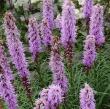
Deep purple blooms. Upright. Compact. Clumping. USDA 3-8
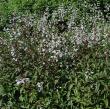
White blooms. Dense maroon and green foliage. Clumping. USDA 3-8
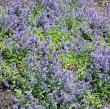
A beautiful variety that attracts an abundance of pollinators. Clusters of dense, lavender flower stalks. USDA 3-8
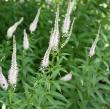
Elegant and showy soft spikes of white, pale pink, or bluish purple flowers. Provides a strong accent and good vertical height. USDA 3-8
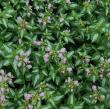
Pink blooms. Green leaves have white diamond. Groundcover. USDA 3-8
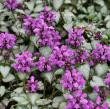
Dense spikes of rich purple flowers that appear above bright silvery foliage. USDA 3-8
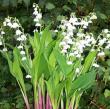
Plants form a spreading clump of large green leaves, bearing short spikes of fragrant white bells in late spring. Takes a year or two to establish, then spreads quickly. USDA 3-8
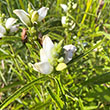
Height: 3 feet
Spread: 30 inches
Sunlight: full sun partial shade
Hardiness Zone: 3a
Other Names: Shellflower
Description:
The white hooded flowers on this perennial make it a great addition to the garden; thrives in wet or moist areas; attracts butterflies
Ornamental Features:
Turtlehead has masses of beautiful white hooded flowers with shell pink overtones at the ends of the stems from late summer to mid fall, which are most effective when planted in groupings. The flowers are excellent for cutting. Its serrated pointy leaves remain dark green in color throughout the season.
Landscape Attributes:
Turtlehead is a dense herbaceous perennial with an upright spreading habit of growth. Its medium texture blends into the garden, but can always be balanced by a couple of finer or coarser plants for an effective composition.
This plant will require occasional maintenance and upkeep, and is best cleaned up in early spring before it resumes active growth for the season. Gardeners should be aware of the following characteristic(s) that may warrant special consideration: Spreading
Turtlehead is recommended for the following landscape applications:
- Mass Planting
- General Garden Use
- Naturalizing And Woodland Gardens
- Bog Gardens
Planting & Growing:
Turtlehead will grow to be about 3 feet tall at maturity, with a spread of 30 inches. Its foliage tends to remain dense right to the ground, not requiring facer plants in front. It grows at a medium rate, and under ideal conditions can be expected to live for approximately 12 years. As an herbaceous perennial, this plant will usually die back to the crown each winter, and will regrow from the base each spring. Be careful not to disturb the crown in late winter when it may not be readily seen!
This plant does best in full sun to partial shade. It is quite adaptable, prefering to grow in average to wet conditions, and will even tolerate some standing water. It is not particular as to soil pH, but grows best in rich soils. It is somewhat tolerant of urban pollution. Consider applying a thick mulch around the root zone over the growing season to conserve soil moisture. This species is native to parts of North America. It can be propagated by division.
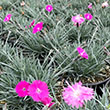
Fragrant pink blooms. Tufted, Mounded habit. USDA: 3-8
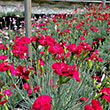
Fragrant red blooms. Frilled double flowers. USDA 3-8
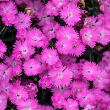
Plant Height: 6 inches
Flower Height: 8 inches
Spacing: 8 inches
Sunlight: full sun
Hardiness Zone: 3a
Other Names: Cheddar Pinks, Clove Pinks
Description:
A robust variety bearing single, fuchsia flowers in late spring to early summer, over a cushion of blue-green, grass-like leaves; has a mild, clove-like, spicy fragrance; will sporadically re-bloom throughout the summer
Ornamental Features:
Firewitch Pinks has masses of beautiful fragrant fuchsia frilly flowers with white eyes at the ends of the stems from late spring to mid summer, which are most effective when planted in groupings. The flowers are excellent for cutting. Its attractive grassy leaves remain silvery blue in color throughout the year.
Landscape Attributes:
Firewitch Pinks is an herbaceous evergreen perennial with a mounded form. It brings an extremely fine and delicate texture to the garden composition and should be used to full effect.
This plant will require occasional maintenance and upkeep, and is best cleaned up in early spring before it resumes active growth for the season. It is a good choice for attracting bees and butterflies to your yard, but is not particularly attractive to deer who tend to leave it alone in favor of tastier treats. It has no significant negative characteristics.
Firewitch Pinks is recommended for the following landscape applications:
- Mass Planting
- Rock/Alpine Gardens
- Border Edging
- General Garden Use
- Container Planting
- Planting & Growing
Firewitch Pinks will grow to be only 6 inches tall at maturity extending to 8 inches tall with the flowers, with a spread of 10 inches. When grown in masses or used as a bedding plant, individual plants should be spaced approximately 8 inches apart. Its foliage tends to remain low and dense right to the ground. It grows at a medium rate, and under ideal conditions can be expected to live for approximately 5 years. As an evegreen perennial, this plant will typically keep its form and foliage year-round.
This plant should only be grown in full sunlight. It prefers to grow in average to moist conditions, and shouldn't be allowed to dry out. It is not particular as to soil type or pH. It is highly tolerant of urban pollution and will even thrive in inner city environments. This is a selected variety of a species not originally from North America. It can be propagated by cuttings; however, as a cultivated variety, be aware that it may be subject to certain restrictions or prohibitions on propagation.
Firewitch Pinks is a fine choice for the garden, but it is also a good selection for planting in outdoor pots and containers. It is often used as a 'filler' in the 'spiller-thriller-filler' container combination, providing a mass of flowers and foliage against which the thriller plants stand out. Note that when growing plants in outdoor containers and baskets, they may require more frequent waterings than they would in the yard or garden.
56 found, showing page 4 of 4




